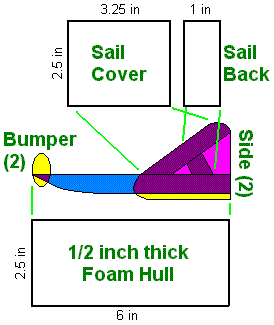A fast Raingutter Regatta boat can be built from cheap, easily crafted materials. If your kit does not contain materials like foam board, thin balsa and birch work best. Dowels and sail cloth are no match for rigid sails made of foam, cut styrofoam cups, card stock or plastic.
| BSA: If you have a Boy Scout kit, check with your regatta coordinator about your options. You will want to make your boat more like the simple hydroplane described here. |
|---|
For easiest crafting, make your hull from a 1/2-inch or 3/4-inch thick piece of insulation foam board. You can easily shape this using a serated knife and sandpaper. Separate pieces of thin wood stock, like balsa is the next best. If you must use a block, have it cut it up into thin pieces. You will have much more control over shape and weight.
No matter what your hull is made of, your raingutter regatta boat requires some up front design. If properly constructed, you may be able to blown it across a ten-foot, water-filled raingutter in less than 3 seconds.
These steps show how to make a simple, fast hull in about 2 days. Feel free to alter the design. Make and finish as many of your deck-o-rations as you can before attaching them to this hull. Make it light, blow it right and the bottom of your hull skims the water surface at great speed. Note the optional steps.
